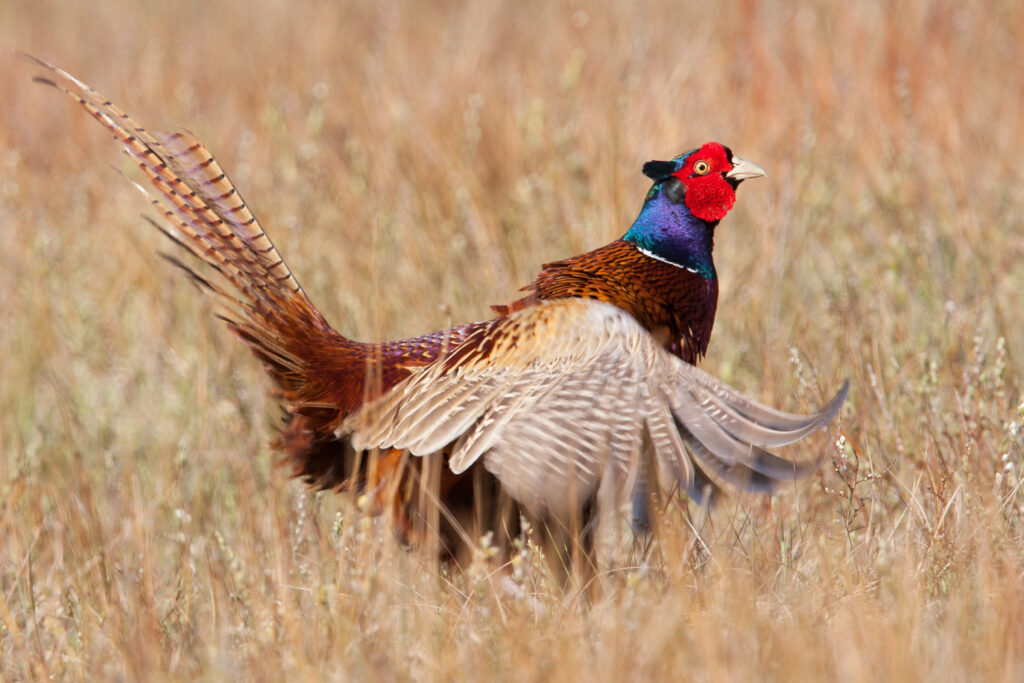Pheasant hunting is more than just a pastime; it’s a tradition that connects people to nature and challenges their skills in a captivating outdoor environment.
With its unique blend of strategy, skill, and the thrill of the chase, this activity draws hunters from all walks of life, eager to experience the excitement of the hunt.
Understanding the essentials of pheasant hunting is crucial for both novice and seasoned hunters seeking a successful outing.
Preparation begins long before stepping foot into the field.
Selecting the right gear, understanding hunting strategies, and being informed about regulations are vital components that contribute to a rewarding experience.
From the careful selection of firearms and ammunition to dressing appropriately for the elements, each aspect requires thoughtful consideration to enhance performance and safety while out in the wild.
In this article, we will navigate through the essential gear and preparation needed for a successful pheasant hunting experience.
We’ll cover everything from hunting strategies and firearm selection to the importance of safety courses and finding the best hunting locations.
Whether you’re a beginner or looking to refine your skills, this guide aims to support your journey into the world of pheasant hunting.
Understand Pheasant Hunting Strategies
Pheasant hunting is a traditional outdoor activity that combines skill, patience, and knowledge of upland birds, particularly the ring-necked pheasant.
To ensure success, hunters must engage in pre-season scouting.
This involves identifying areas with abundant pheasant habitat, such as native grasses, corn fields, and other favorite cover types, essential for wild pheasant populations.
Access to these areas requires permission, especially on private lands, so reaching out to landowners is crucial.
Utilizing trained bird dogs is an integral part of hunting pheasants.
These dogs excel in locating birds and retrieving downed game, enhancing the hunter’s efficiency.
It’s also vital to respect fellow hunters; maintaining proper etiquette ensures an enjoyable experience for all on public and private lands alike.
For fruitful pheasant hunts, regions such as the upper Midwest, Northern Great Plains, and Rocky Mountain states offer great opportunities, with South Dakota being a hub for pheasant hunters due to its rich tradition of pheasant hunting.
A favored method by seasoned hunters is the pushing and blocking technique. This approach requires coordination and teamwork as one group drives birds towards another, effectively cornering the rooster pheasants.
Remember to verify the season dates and secure a hunting license before heading out. This will align your efforts with the pheasant season and abide by game bird management regulations.
Select the Right Firearm for Pheasant Hunting
Pheasant hunting requires careful consideration when it comes to selecting the right firearm.

While pheasant hunters are permitted to use shotguns that hold more than three shells and .22 caliber rimfire rifles with specific types of ammunition, it is essential to choose a gun that matches one’s hunting style and conditions.
For hunters who traverse vast distances with close-working dogs, a lightweight 20-gauge, 28-gauge, or .410 shotgun may be the best fit, particularly when pursuing released upland birds.
These lighter shotguns are also easier for smaller-framed hunters to manage.
On the other hand, if the hunt is likely to present longer shots, especially at wild birds later in the season when they become more wary and flushed at greater distances, a 12-gauge shotgun with a long barrel is the preferred tool.
A 12-gauge allows for heavier shot loads, typically size 4 or 5, which are more effective on robust game birds such as the ring-necked pheasant.
The ideal shotgun, choke, and ammunition load for pheasant hunting can vary extensively based on individual preference and distinct hunting scenarios.
However, many hunters find a balance between these two extremes, with an all-around combination that provides versatility in most hunting situations.
Consider Gauge and Action Type
When it comes to selecting a shotgun for pheasant hunting, the gauge and action type are pivotal factors.
The shotgun should fit the hunter well, with a comfortable length and weight that allows for quick shouldering and aiming.
Gauge choice often depends on the hunting environment and the shooter’s preference, with 12-gauge being a common pick thanks to its versatility.
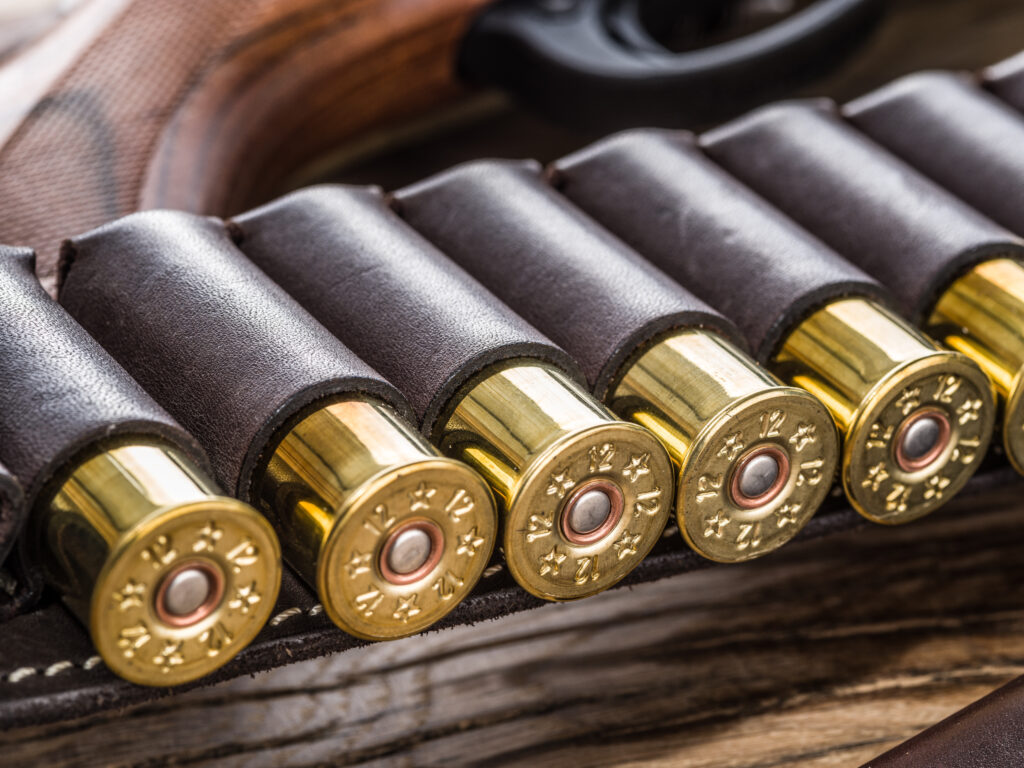
The lead shot sizes used typically range between 7 ½ to 4, though size 6 is commonly favored for its balance between range and power.
Steel shot may be required in some areas, and hunters should always be aware of local regulations regarding ammunition.
Action type also plays a role in the hunting experience, with options such as semi-automatic, pump-action, over-and-under, and side-by-side shotguns each offering different advantages in terms of rate of fire, reliability, and personal comfort.
Recommended Firearms for Beginners
For newcomers to the tradition of pheasant hunting, selecting the right firearm can feel daunting.
A wise choice for those stepping into pheasant fields for the first time is a lightweight 20-gauge shotgun, which is maneuverable and conducive to covering a lot of ground without undue fatigue.
This gauge is well-suited for birds that are released and typically encountered at closer ranges.
Meanwhile, hunters who expect to engage wild birds at longer distances should consider a 12-gauge shotgun with a heavy load and a long barrel for enhanced accuracy and power.
The 12-gauge shotgun remains the most popular among pheasant hunters, striking an effective balance for various conditions and offering a sufficient load size for longer-range shots.
Beginner hunters should also be mindful of the recommended shot sizes.
Sizes 4 or 5 are favorable for distance shooting, while 6 and 7 ½ are better for closer targets. Considering these factors, beginners can make an informed choice that enhances their chances of success and enjoyment in the field, while also abiding by ethical hunting and safety standards.
Choose Appropriate Ammunition
When it comes to pheasant hunting, selecting the appropriate ammunition is just as crucial as choosing the right firearm.
The spectrum of effective shotgun gauges for hunting pheasants is quite broad, stretching from the diminutive yet capable .410 to the more robust 28, 20, and 12 gauges.
While lightweight options like the .410 or 28-gauge might appeal to smaller hunters, or those engaging in upland bird hunting with released pheasants, the spreads produced by these gauges generally suit closer ranges.
In contrast, the 20-gauge shotgun offers a suitable middle ground, especially when chambered for three-inch shells, providing a push in firepower without a significant increase in weight or recoil.
Rooster pheasants, known for their caginess, may require that hunters opt for the staple 12-gauge, paired with heavier loads when expected to take longer shots.
You should be aware that some regions mandate the use of steel shot as opposed to traditional lead; this calls for a careful attention to local hunting regulations.
A responsible choice in some areas may be Federal Premium Ammunition’s Pheasants Forever shells, which cater to the need for both lead and steel shot options, addressing conservation concerns and regulatory compliance.
An optimal shotgun setup should be tailored not just to gauge and preference but also to suit different hunting situations.
An improved cylinder bore can be supremely useful for the first shot at a closer flushing bird, while subsequent shots may call for a modified or full choke, particularly if the pheasants seek escape at farther distances.
The choice of ammunition will ultimately hinge on the hunting conditions, personal preference, and regulations, making it imperative for hunters to assess the situation and prepare accordingly.
Types of Shotgun Shells
With the 12-gauge’s prevalent status in pheasant hunting, it’s easy to overlook the smaller 20-gauge, which can prove both effective and user-friendly,
particularly for smaller or younger hunters. This shotgun can pack substantial power, enough to down a wild pheasant, when used with three-inch shells.
Yet, it’s important to remember that shotgun shells come in an array of gauges and lengths, from the .410 to the significant payload capacity of a 12-gauge, allowing hunters to customize their choice to their comfort level and the demands of the pheasant hunt.
Hunters should recognize there is no one-size-fits-all when it comes to selecting shotgun shells; various options may be optimal for different scenarios, and adaptability is key.
A significant consideration is local regulation—areas may mandate the use of steel shot for environmental reasons, underscoring the importance of adapting to local hunting rules.
The breadth of choice allows for significant experimentation to find the ideal combination for each individual’s pheasant hunting experience.
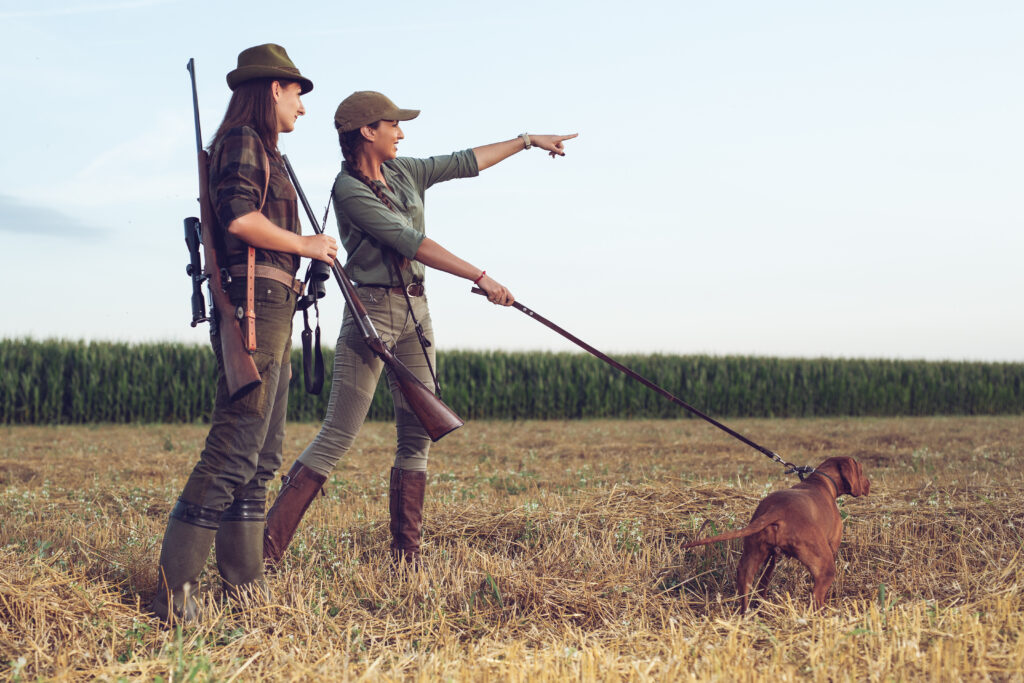
Understanding Shot Size and Load
The shot size, which determines the number of pellets per cartridge, is a defining factor in hunting success.
Pheasant hunters frequently favor lead shot sizes from 4 to 7 ½, with size 6 shot being a versatile pick for general use.
The larger the shot size, such as 5s or 4s, the more suitable it is for longer-range encounters due to superior knock-down power.
Standard loads for a 12-gauge shotgun often consist of a 2 ¾-inch shell loaded with an ounce and a quarter of lead shot—a popular choice that balances shot density with recoil management.
However, for hunters seeking a tighter spread or hunting in denser cover, larger three-inch shells may be the go-to.
These shells have the capacity for up to 1 ¾ ounces of shot, allowing for a denser pattern which might just turn a missed shot into a successful bag.
In specific regions that require nontoxic shot, such as parts of Washington, the available shot choices become more constrained, impacting both the load and the potential performance of the ammunition.
In conclusion, the array of gauges, shell lengths, shot sizes, and load options ensures that there’s a suitable ammunition choice for every hunter, preserving the tradition of pheasant hunting across the diverse landscapes of public and private lands.
Whether navigating through corn fields or native grasses, understanding the nuances of shotgun shells will not only comply with regulations but also significantly improve the odds of a successful pheasant hunt.
Dress for Success: Essential Attire
Embarking on a pheasant hunting expedition requires not only skill and knowledge of the game but also the right attire to ensure a safe and successful hunt.
An integral part of this attire is the mandatory wearing of at least one visible article of clothing above the waist that is blaze orange or pink.
This is not just a stylistic choice but a safety requirement designed to enhance visibility amongst hunters.
To adapt to varied weather conditions, layering clothing is key.
Layers allow hunters to add or remove pieces to maintain comfort, whether the day turns unseasonably warm or unexpectedly chilly.
Starting with a moisture-wicking base layer and adding an insulating layer and a protective outer shell ensures preparedness for any weather.
Reliable field gear further rounds out the necessary attire for pheasant hunting.
Durable and protective boots are non-negotiable for traversing different terrains, while hats and gloves offer additional protection from the elements. Vests not only add to visibility but also provide convenient storage for shells and game.
Comprehensive protection comes from adding chaps, which shield the legs from thick brush and briars.
Before setting foot in the field, understanding local blaze orange regulations is critical to ensure compliance and maintain the highest level of safety.
Required Clothing for Different Weather Conditions
Pheasant season often spans a range of weather conditions, making the saying “there is no bad weather, only bad clothing” all the more relevant for pheasant hunters.
For early-season hunting, when temperatures can be mild, lightweight and breathable attire is preferable.
Conversely, in the late-season when the cold sets in, insulated jackets, thermal layers, windproof outer garments, and a warm hat become essential.
Here’s a guide to clothing for different weather conditions:
| Weather Condition | Suggested Clothing Items |
|---|---|
| Mild | Lightweight, breathable layers |
| Cold | Thermal layers, insulated jackets |
| Rainy | Waterproof outerwear, water-resistant hat |
| Windy | Windproof jackets, snug-fitting caps |
No matter the forecast, hunters must wear at least one piece of clothing above the waist that is blaze orange or pink to comply with safety regulations. State laws may vary, so it is imperative to review the blaze orange requirements specific to the area and season.
Footwear for Comfort and Safety
The right boots are a cornerstone of any hunter’s attire due to their role in safety and overall comfort.
Hunting pheasants often requires extensive walking over uneven and potentially challenging terrain.
Sturdy boots with ample ankle support, aggressive tread for traction, and water-resistant or waterproof materials are necessities. Not only do they help combat fatigue, but they also prevent injuries that could occur from a misstep.
Opting for boots that integrate blaze orange or pink can further enhance safety, aligning with visibility standards set for clothing.
When selecting boots, consider the conditions expected during the hunt and ensure an adequate break-in period to avoid discomfort, such as blisters, during a long day of hunting.
Importance of Blaze Orange Gear
Visibility in the field is a matter of life and safety during pheasant hunts.
Pheasant hunters must wear at least one article of clothing above the waist in blaze orange or pink—this color is easily discernible against the natural backdrop of hunting environments.
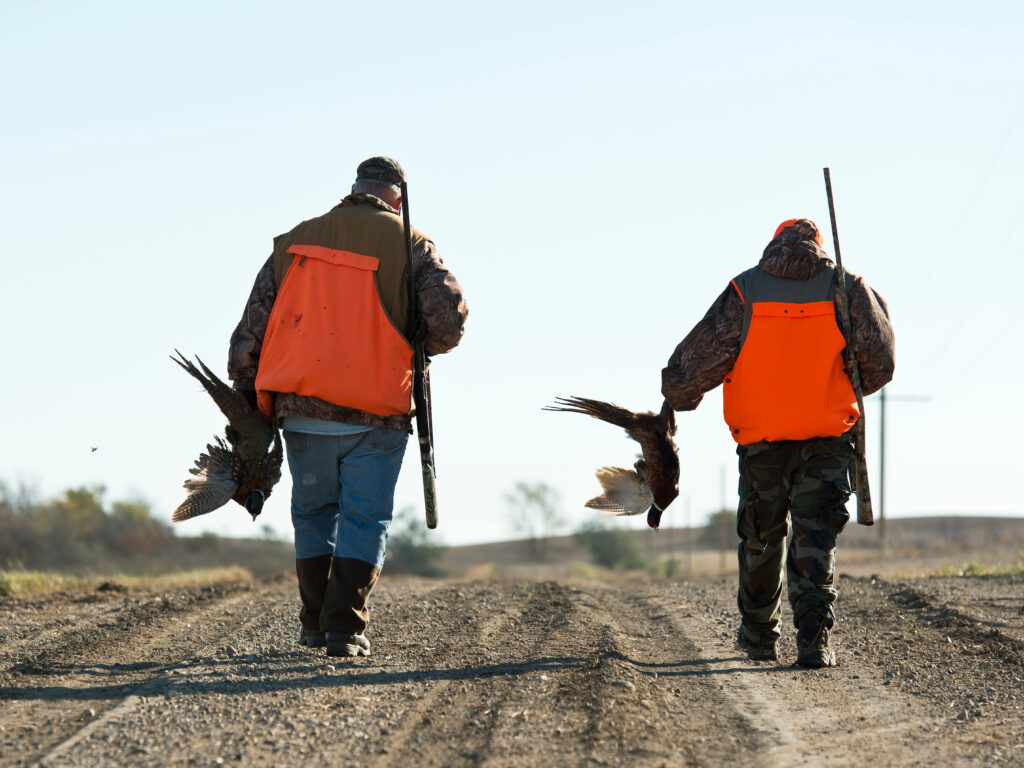
The choice to wear more blaze orange is not only smart but can be seen as an extension of hunter ethics, emphasizing the collective responsibility towards accident prevention.
| Blaze Orange Gear | Purpose |
|---|---|
| Vest | Adds visibility and convenient storage |
| Hat | Ensures head visibility and warmth |
| Jacket | Provides warmth and high visibility |
Apart from being a requirement, high-visibility gear made from sturdy materials can also protect against abrasions from rough terrain and provide additional storage for hunting essentials.
Before the hunt, familiarize yourself with the blaze orange laws and regulations specific to your hunting location to ensure both compliance and safety in the upland fields.
Find a Mentor for Guidance
Embarking on the journey of pheasant hunting can be a rewarding experience, especially when guided by the wisdom of a seasoned veteran.
State wildlife agencies understand this and often provide resources to aid beginners in connecting with a mentor.
These mentors can deliver invaluable lessons on hunting techniques, strategies, and the traditions of pheasant hunting that can only be learnt through field experience.
Additionally, many areas feature local chapters of organizations such as Pheasants Forever, which regularly hosts mentored hunts.
These events present an excellent opportunity for novices to practice and learn in a supportive atmosphere, honing their skills alongside experienced pheasant hunters.
Joining a mentored hunt not only instills the essential skills and etiquette required for successful upland bird hunting, but it also embeds a deeper appreciation for this storied outdoor tradition.
Moreover, a mentor can help a new hunter understand the various regulations and necessary field etiquette, ensuring the pursuit of game birds is done responsibly and effectively.
Through mentorship, beginners can smoothly navigate the landscapes of public and private lands, decipher season dates, and appreciate the nuances of pheasant habitat and conservation.
For those looking to cultivate a passion for hunting wild pheasants, finding a mentor could be the cornerstone of becoming a proficient and respectful pheasant hunter.
Identify Top Pheasant Hunting Locations
Pheasant hunting is a treasured tradition in many parts of the United States, with South Dakota at the pinnacle of destinations for hunters seeking the thrill of pursuing upland birds.
Towns like Aberdeen in South Dakota have carved out an esteemed reputation, with Aberdeen proudly known as the “Pheasant Hunting Capital of the World.”
The state’s habitat for pheasants is optimal, leading to high wildlife population densities, making it an esteemed getaway for pheasant hunters.
Counties like Brown, Beadle, Brule, Lyman, and Spink are particularly noteworthy, boasting the highest pheasant harvest numbers in the state due to their diverse and favorable habitats.
Pheasant season in these areas sees a flux of hunters eager to track down the cherished ring-necked pheasant amidst the rich landscapes.
Beyond South Dakota, states such as North Dakota, Nebraska, Kansas, Iowa, Minnesota, and eastern regions of Colorado, Wyoming, and Montana also provide extensive opportunities for pheasant hunting.
These states offer a mix of agricultural areas and open grasslands — the preferred roosting and foraging grounds for pheasants.
These landscapes are often populated with crops like corn and wheat, which serve as favorite cover for pheasants, creating prime hunting spots.
Access to pheasant hunting is not just confined to private lands. Many of these states, including South Dakota, have vast expanses of public lands, offering hunters the ability to engage in the sport without the challenge of obtaining private land permissions.
The variety and abundance of both public and private lands cater to a range of hunting preferences and ensure the tradition of pheasant hunting continues to flourish across these top locations.
Public Lands: Pros and Cons
Public lands are an indispensable asset for pheasant hunters, offering a wealth of opportunity across the United States.
Within these lands, one can find a mosaic of hunting grounds, including U.S. Fish and Wildlife Service Waterfowl Production Areas, state-owned reserves, and Game Production Areas that open their proverbial doors during pheasant season.
This variety is essential in catering to the diverse preferences of pheasant hunters.
Such lands come with their set of pros, such as vast areas designated for the public to enjoy the tradition of upland bird hunting and cooperative programs with private landowners that increase available acreage for hunting.
These initiatives ensure that hunters are not solely reliant on private lands, providing them with ample choice and maintaining robust wild pheasant populations through regulated hunting.
However, public lands are not without their cons. As these areas are available to everyone, the density of hunters can vary, affecting the hunting experience and success rates.
Some public lands may experience high pressure during pheasant season, resulting in cautious and elusive game birds.
Furthermore, regulations on these lands mean hunters must secure appropriate hunting licenses and adhere to bag limits, protecting the sustainability of pheasant hunting for future generations.
A potential challenge is the accurate identification of accessible areas, as public hunting lands maps may not always reflect the most recent changes or walk-in areas, thus necessitating careful planning and research before embarking on a hunt.
Private Properties: Access and Etiquette
Securing access to private lands for pheasant hunting calls for a proactive and respectful approach.
This begins with an introduction to landowners, courteously seeking their permission well in advance of the hunting season.
Scouting trips not only allow hunters to evaluate the presence of pheasants but also to create and maintain a relationship with landowners — a critical aspect if hunters hope to return in subsequent seasons.
Building a rapport is key, and demonstrating a respectful and responsible exhibition of hunting etiquette goes a long way in establishing trust.
The recognition of property boundaries, heeding the landowners’ stipulations, and expressing gratitude for the access are cornerstones of maintaining a good relationship and ensuring the possibility of future entry to these cherished hunting grounds.
When it comes to etiquette, hunters should strive to leave the land as they found it, taking care to close gates, avoid damaging crops or property, and picking up any litter, including spent shotgun shells.
By honoring these unwritten rules of conduct, hunters can help perpetuate the tradition of pheasant hunting for years to come, echoing the spirit of conservation and respect for the land and its proprietors.
Understanding Pheasant Habitat
Pheasants require environments where the essentials—food, cover, and water—are readily available to thrive.
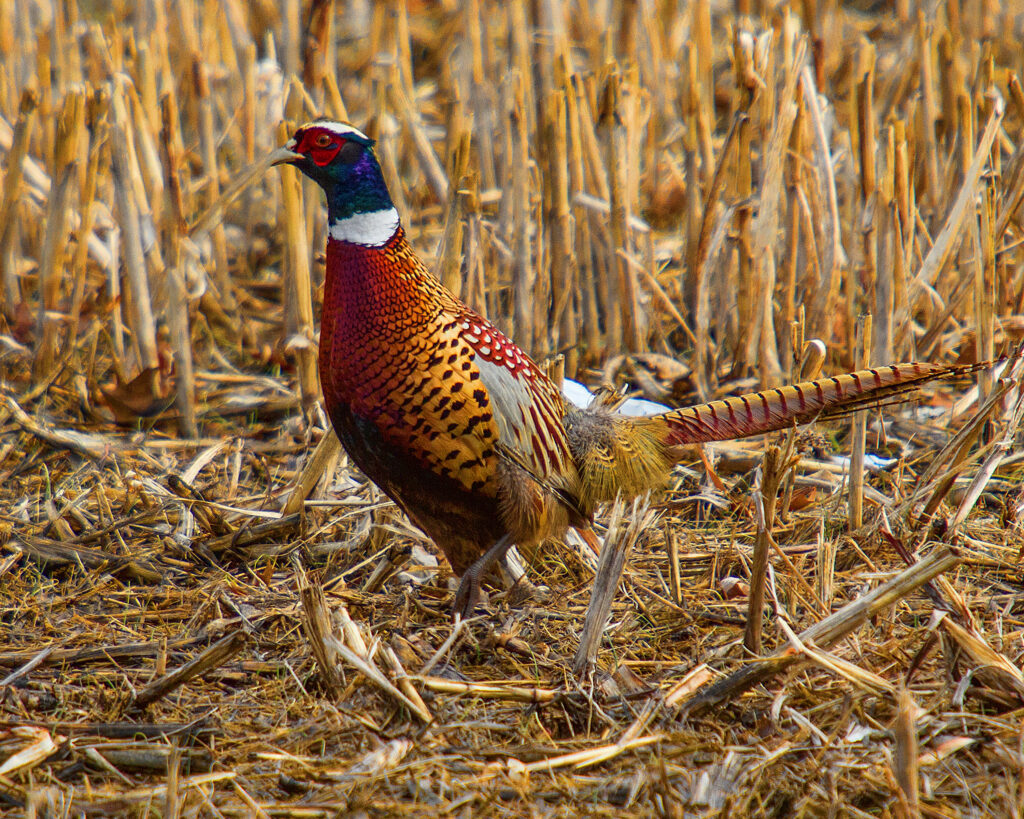
These birds are often synonymous with agricultural landscapes due to the bounty of resources such lands provide.
Mixed grasses, weeds, and the residual grain of harvested fields create a mosaic of sustenance, nesting, and hiding spots for pheasants, making certain agricultural regions hotspots for pheasant activity.
The most suitable habitats for pheasants tend to include areas that have not been heavily modified by modern agricultural practices or urban development.
Historically, pheasant populations have faced challenges with changes in land use, particularly after the 1940s, when intensified farming methods and expanding cities began limiting available habitats.
In response, some states, like Washington, have introduced programs such as releasing pen-raised birds to bolster wild populations, particularly in prime grain-producing areas on the east side of the state.
Recognizing that pheasant habitats are dynamic—not static—environments is crucial. Seasonal shifts drive pheasants to adapt their behavior and location.
For example, during colder months, pheasants may forage in heavier cover during the day and then shift to open areas like corn fields or crop fields to roost as the day wanes. This daily transition from feeding areas to roosting sites is a critical aspect of pheasant behavior that hunters and conservationists must heed.
Time Management During Your Hunt
Pheasant hunting, a tradition cherished by many, is not only about skill and knowledge but also hinges on efficient time management. Successful hunters proactively scout and plan their locations well before the season opens.
This forethought allows for strategic decision-making and better allocation of time during actual hunts. Without proper planning, hunters might squander precious hunting hours on opening day trying to find their optimum spot.
Respecting fellow hunters’ space is not only a matter of etiquette but also ties into time efficiency. Avoiding crowded areas can lead to a more enjoyable and often more rewarding hunt.
This approach minimizes disturbances that could potentially spook pheasants and provides a more serene environment for both hunters and their bird dogs.
Physical fitness for both the hunter and the hunting dog cannot be overstated.
A seasoned hunter knows that keeping in good shape will help maximize time in the field and ensure a safer, more effective season.
A healthy, well-conditioned dog is more adept at tracking down pheasants and retrieving them without losing steam too quickly.
Awareness of local hunting conditions is another timesaver. Smart hunters check the status of roads, fields, and weather forecasts the night before a planned hunt.
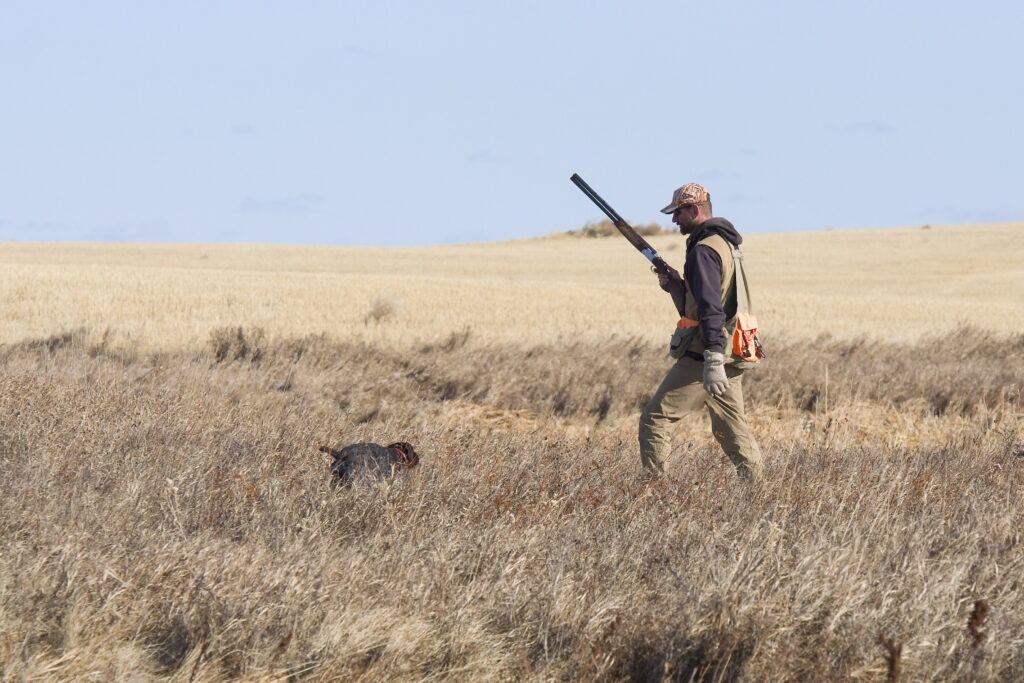
Conditions like closed routes or flooded terrains can derail plans and, if not anticipated, can waste hours that could have been spent on productive hunting.
Lastly, deploying a combination of pointing and flushing dogs can significantly enhance time efficiency in the field.
These dogs complement each other – the pointers help locate the pheasants, and the flushers aid in driving the birds into the open.
This strategy is particularly effective across various terrains, often reducing the time needed to locate and retrieve these upland birds.
Best Times of Day to Hunt
Understanding pheasants’ daily patterns is essential for any pheasant hunter. These birds are especially active during two critical periods; the first two hours after sunrise and the last couple of hours before sunset.
These are the prime times for hunters to take to the fields. Early morning offers a fresh start, as pheasants leave their roosts in search of food.
Late afternoon, conversely, can be just as productive. Pheasants typically exit heavy cover and venture into open spots to roost, presenting hunters with excellent opportunities.
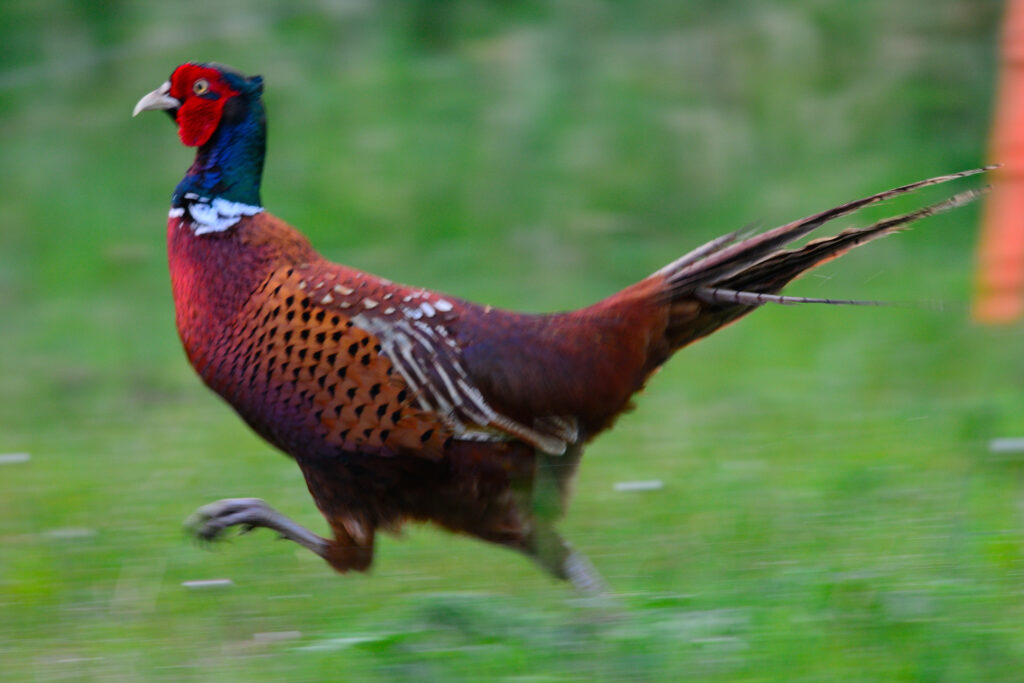
Grassy areas adjacent to cornfields are popular with ringnecks, especially in the dwindling hour of daylight. This behavior makes such spots invaluable for a successful hunt.
Those who persevere into the late season can also find success, with birds often becoming less cautious as hunting pressure wanes.
As the season progresses, pheasants may adapt and shift their patterns, but scouting transitional habitat areas, where one landscape meets another, can provide consistent hunting opportunities throughout the day.
Planning Your Hunt Schedule
Pheasant season, a period full of anticipation for hunters, runs from August 15 to April 30. Such an extended season allows for thoughtful planning of pheasant hunts.
Hunters can choose from various options, including traditional half-day mixed bird hunts, which typically include up to 4 pheasants and 8 quail or chukar per gun.
This option provides a rich, diverse hunting experience within a manageable timeframe.
Places like Meemo’s Farm cater to different preferences by offering hunts at designated times like 9 AM and 1 PM. This flexibility supports hunters in fitting hunts into their busy schedules.
For a more varied experience, the Cast & Blast package presents an opportunity to blend pheasant hunting with river fishing, requiring a minimum participation of 2 people for a more communal adventure.
Legal and sustainable harvest management is essential in ensuring future hunting opportunities.
Daily limits are established at 3 rooster pheasants per hunter, with a possession limit of 15.
Adhering to these regulations is part of responsible pheasant management, and helps hunters enjoy the sport while conserving wild pheasant populations for seasons to come.
Importance of Staying Informed
Staying informed about pheasant management and hunting opportunities is beneficial for new and experienced hunters alike.
For example, New York’s Adult Pheasant Release Program (APRP) raises and releases approximately 30,000 adult pheasants into public hunting areas annually.
These efforts are expected to increase, with plans to grow the number to 50,000 by 2024. This program significantly enriches hunting possibilities by supplying pheasants for Department of Environmental Conservation (DEC)-approved sponsored hunts that focus on increasing participation among youth, women, and novice hunters.
Familiarity with these pheasant management initiatives underscores the importance of hunting regulations.
For example, compliance with requirements such as the necessity for non-residents aged 65 and older to hold a pheasant stamp and small game license contributes to sustainable pheasant populations.
Moreover, understanding the economics of hunting, including the substantial financial impacts that resident and non-resident hunters bring to local communities, allows us to appreciate the broader role pheasant hunting plays in both rural and state economies.
It is clear that staying informed not only aids in the observance of laws and contributes to wildlife conservation, but also helps foster a positive relationship between individuals and their outdoor environments, ensuring that the tradition of pheasant hunting continues to thrive.
Resources for Ongoing Education and Preparation
For those passionate about the pursuit of pheasants and eager to respect the storied tradition of upland bird hunting, ongoing education and preparation are essential.
In New York, pheasant hunting has been an integral part of the outdoor experience since its first season was established in 1908. In keeping with this tradition, the DEC’s Reynold’s Game Farm plays a pivotal role by stocking up to 6,000 pheasants each year, supporting hunts that encourage diverse groups to participate.
Understanding and adhering to local regulations is paramount.
For instance, certain areas mandate the use of non-toxic shot for pheasant hunting. It’s important to familiarize yourself with these laws to ensure both personal and environmental safety.
Furthermore, to accommodate various skill levels and interests, different hunting packages, including overnight and half-day traditional pheasant hunts, offer structured experiences with the guidance of seasoned hunters.
Preparatory steps like consistent shotgun practice and knowing whether to use steel shot or other alternatives are crucial for success in the field.
The presence of heavy cover, such as corn fields and native grasses on both public and private lands, can influence shot selection, emphasizing the importance of understanding cover types and pheasant behavior.
Books and Online Courses
Pre-season preparations, whether through perusing informative books or engaging in online courses, are invaluable for both new and veteran pheasant hunters.
Gaining insights into where upland birds like the ring-necked pheasant prefer to roam can greatly improve chances of a successful hunt.
Pre-season scouting is vital for identifying favorite cover types and getting permission from landowners to hunt on private lands.
Moreover, employing well-trained bird dogs is an aspect that enhances the hunt and necessitates its own preparation. From selecting the right breed to training your companion effectively, resources are available to guide you in optimizing your bird dog’s skills.
Maintaining physical fitness cannot be understated; it creates a more enjoyable and safe hunting experience for both the hunter and their dogs.
Books on sports fitness, as well as online conditioning programs tailored for hunters, can ensure you’re in top shape for the season.
Lastly, online courses and local workshops can provide instruction on respecting the space of fellow hunters and understanding the dynamics of hunting on public lands, which may sometimes experience a high volume of pheasant hunters during peak times of the season.
Conclusion: Preparing for a Successful Hunt
Conclusion: Preparing for a Successful Hunt
To ensure a successful pheasant hunting adventure, it’s paramount to embark on pre-season scouting, identifying areas teeming with upland birds.
Whether you pursue ring-necked pheasants on public lands or private lands, understanding the lay of the land and the favorite cover such as corn fields and native grasses can set you up for success. Here’s a summary to help you get ready:
- Pre-season Scouting – Map out potential hotspots and wild pheasant populations.
- Safety First – Establish clear safety protocols with all members of your hunting party.
- Bird Dogs – Trained dogs can be invaluable in finding and retrieving rooster pheasants.
- Adapt Tactics – As the season progresses, target heavy cover in less-visited areas.
- Hunting Etiquette – Share the hunting fields with respect and consideration for others.
Remember, the tradition of pheasant hunting doesn’t just start with the season’s dates; responsible pheasant management and habitat conservation are year-round commitments.
Acquiring the right hunting license, being up-to-date on regulations, and practicing good stewardship ensures the sustainability of wild pheasants and contributes to the overall enjoyment of this time-honored practice. Good luck out there, and safe hunting!
Read also : Duck hunting guide or Goose Hunting Guide

